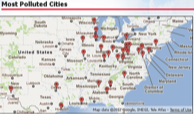
AIR POLLUTION
AND AUTISM RISK
by
Travis Thompson
Left Andrea L Roberts
A newly published study by Andrea L. Roberts and her colleagues at the Harvard University School of Public Health indicates a connection between air pollutants and autism risk. Air pollution contains many toxicants known to affect neurological function and to have effects on the fetus in utero. Recent studies have reported associations between perinatal exposure to air pollutants and autism spectrum disorder (ASD) in children. We tested the hypothesis that perinatal exposure to air pollutants is associated with ASD, focusing on pollutants associated with ASD in prior studies. Roberts and colleagues estimated associations between U.S. Environmental Protection Agency modeled levels of hazardous air pollutants at the time and place of birth and ASD in the children of participants in the Nurses’ Health Study II (325 cases, 22,101 controls).

